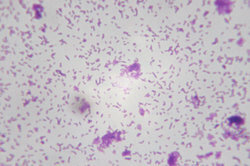How are bacteria built?
Bacteria are single-celled organisms. Accordingly, they have a very similar structure to any other cell in a living organism. However, there are also differences that make bacteria prokaryotes.

Brief profile of the bacteria
Bacteria are single-celled organisms that can be found wherever sterility is not available.
- Bacteria are unicellular, so they are made up of only one cell. They belong to the group of prokaryotes, which means that their DNA is not enclosed by a nuclear membrane - they own So no nucleus, in contrast to the eukaryotes, whose genetic material is combined in a nucleus will.
- Bacteria live everywhere - except in a sterile environment. They also occur in immeasurably large numbers in the human organism - especially in the Gastrointestinal-Track. For example, one third of the bulk of human stool is made up of bacteria. The unicellular organisms can use a living being, live in it without influencing it, or harm it, such as Pathogens do it. Some bacteria are also helpful or not pathogenic in the intestine, but can occur in other parts of the body Diseases trigger.
This is how the prokaryotes are built
As already mentioned, bacteria belong to the prokaryotes - they are therefore structured somewhat differently than the cells of a eukaryote.
- The most important differentiation between bacterial cells and eukaryotic cells is the lack of a nucleus. Prokaryotes do not have any - instead, their DNA is freely compressed in the cytoplasm as a nuclear equivalent.
- The basic elements of the bacterium are the cytoplasm, i.e. the cell fluid, a surrounding and the cytoplasmic membrane that separates the environment, the nucleotide, i.e. the DNA, and ribosomes Protein synthesis.
- While a bacterium always has a cytoplasmic membrane, most but not all bacteria have a cell membrane. This can be thick or thin, which is a criterion for its determination.
- The other structures that make up a bacterium are optional, so they do not appear in all of them in the same way. These elements include flagella for locomotion, pili, plasmids, i.e. extrachromosomal DNA molecules, gas vesicles or thycaloids in photosynthesis-producing bacteria.
- The unicellular organisms can have very different shapes. There are spherical bacteria called cocci, rod-shaped, spiral-shaped and other shapes.
They cannot be seen with the naked eye and yet can be quite considerable ...
How helpful do you find this article?
The content of the pages of www.helpster.de was created with the greatest care and to the best of our knowledge and belief. However, no guarantee can be given for the correctness and completeness. For this reason, any liability for possible damage in connection with the use of the information offered is excluded. Information and articles must under no circumstances be viewed as a substitute for professional advice and / or treatment by trained and recognized doctors. The content of www.helpster.de cannot and must not be used to make independent diagnoses or to start treatments.
